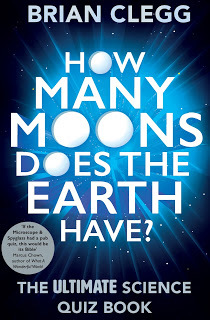
My quiz books
How Many Moons Does the Earth Have?
and
What Colour is the Sun?
are all about asking science questions with interesting or intriguing answers, so I was delighted when a reader, Simon Bartlett, asked about how realistic one of my answers was.
The question here (from
How Many Moons) was 'What is the furthest you can see with the naked eye?' The traditional answer to this is to point out that you can see at least 21 miles (33 kilometres) across the English channel, and it's said that you can see a candle on a truly dark night about 10 miles (16 kilometres) away. However, I wanted to challenge this by pointing out that you can see the Andromeda galaxy with the naked eye (assuming a dark night and good eyesight), and that's around 2.5 million light years. So, bearing in mind this is usually the standard marker for maximum distance naked eye astronomy, I plumped for that. However, Simon felt this should be considered a bit further:
In answering the question 'What is the furthest you can see with the naked eye?', [don't] you answer address a different question, namely 'How far away is the furthest object I can see with my naked eye?' An object brighter in the visible spectrum but further away could still be visible, so I would suggest that the furthest the naked eye can see is limited by two things, neither of which I actually know - how bright is the brightest object visible in wavelengths we can see, and how far away would it have to be to be red-shifted in order to make it no longer visible?
In reality neither of these questions I am supposed to have addressed is ideal. The figure I give for the Andromeda galaxy is a good default maximum as it’s the most distant object you can see with the naked eye
under normal conditions - and that, in effect, delivers the furthest you can see. However, in extraordinary circumstances - when a big enough supernova is at its brightest, for example - you could see further still. Even then, though, there is going to be a limit to the range, as the power drops off with the square of the distance away, so you would need an exponential increase in brightness for an object to still be visible. The brightest known supernova to date, ASASSN–15lh (now possibly not a supernova at all)
is described as having about 20 times the output of the Milky Way - which for our purposes will do as an order of magnitude comparison with the brightness of the Andromeda galaxy. This means you could push back the distance by a factor of around 4.5 and still see an object of this brightness with the naked eye - so we’re talking about maybe 11 million light years. There are brighter things than supernovas, notably quasars, but a lot of their output does not reach us in the visible spectrum - and they are also immensely distant, so they aren’t going to be seen with the naked eye. The brightest detected quasar, 3C273 is surprisingly bright given it's about 2 billion light years away, but
would apparently need an 8 inch telescope to see it - not exactly naked eye stuff.
So my answer certainly wasn't wrong - it still makes sense as one answer to a 'most distant naked eye sighting' - but there's more to be got from that question.
Published on April 21, 2017 01:01
 newest »
newest »
 newest »
newest »
 I remember running across a Wikipedia entry that went to some detail about naked eye astronomy. According to those who investigate the question for certain observers under certain conditions object fainter than magnitude six can be seen.
I remember running across a Wikipedia entry that went to some detail about naked eye astronomy. According to those who investigate the question for certain observers under certain conditions object fainter than magnitude six can be seen.  Interesting coincidence.
Interesting coincidence. 





It's interesting that one can get into a bit of a verbal twist if astronomical objects are included. Apparently the Andromeda galaxy is the farthest thing we can see in the sky because there's nothing farther that we can see, which sounds tautological but isn't. Supernova 1987A was a good deal farther away and was visible with the naked eye, but we can't see it unaided anymore.